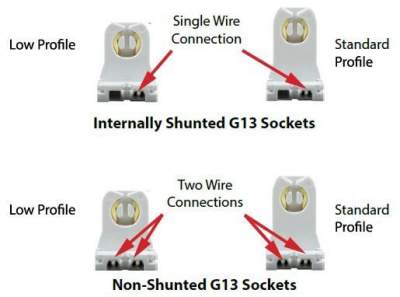
Confused by LED T8 tube options? Unsure if you need single-ended or double-ended LED tubes? Orilis can help by simplifying the jargon!

Understanding Single-Ended and Double-Ended LED Tubes
In a nutshell, single-end powered LED tubes are wired to one end of the tube only, while double-end powered LED tubes are wired to both ends. It's important to note that these tube types are not interchangeable, as the wiring will be different for each type.
Read more: 3 Steps To Make Different Color LED Lights: DIY Method
Double-Ended LED Tube
A double-ended LED tube is a tube where the live and neutral pins are located on the opposite sides of each tube. This design is similar to fluorescent tubes, making retrofit applications easier when using double-ended LED tubes.
When upgrading to LED tubes using an LED Retrofit Kit, you can reuse the existing tombstones if they are in good condition. This can help reduce the average retrofit installation time. However, it's essential to check the tombstones for any damage. Old tombstones may be broken due to long exposure to heat or frequent tube replacements. If damage is found, it is best to replace them.

Single-Ended LED Tube
A single-ended LED tube is a tube where the live and neutral pins are located on the same side of the tube. This side is known as the "Input" end. You can easily identify a single-ended tube by looking for the L/N or AC INPUT sticker at the end of the tube.
Since single-ended powered tubes use only one side of the tube, both live and neutral power will be on the same side but with different pins. The "L" indicates the pin for live power, while the "N" indicates the pin for neutral power.
If you are installing a single-ended LED tube as part of an LED Retrofit Kit into a fluorescent fixture, you will need to replace the existing fluorescent, shunted tombstones with non-shunted tombstones on at least one side of the fixture, specifically the 'live' or powered end of the fixture.
Read more: How to Make Copper Wire LED Lights
Frequently Asked Questions
Q: Can I use single-ended and double-ended LED tubes interchangeably?
A: No, single-ended and double-ended LED tubes have different wiring requirements, and they are not interchangeable. Make sure to choose the correct type for your specific light fixture.
Q: Are single-ended or double-ended LED tubes more efficient?
A: Both single-ended and double-ended LED tubes offer similar energy efficiency. The choice between them depends on the existing wiring in your light fixture and the ease of installation.
Q: Can I use an LED Retrofit Kit with both single-ended and double-ended LED tubes?
A: Yes, you can use an LED Retrofit Kit with both types of LED tubes. However, you need to ensure that the tombstones and wiring are compatible with the chosen tube type.
Q: Are single-ended or double-ended LED tubes more cost-effective?
A: The cost-effectiveness of single-ended and double-ended LED tubes depends on various factors, including the specific light fixture, installation requirements, and maintenance costs. It's best to consult with a lighting professional to determine the most cost-effective option for your needs.
Q: Are there any safety considerations when installing LED tubes?
A: When installing LED tubes, it is important to follow safety guidelines and instructions provided by the manufacturer. Ensure that the power is turned off before installing or removing tubes and consult a qualified electrician if needed.
Read more: How Long do Solar Lights Last?


























